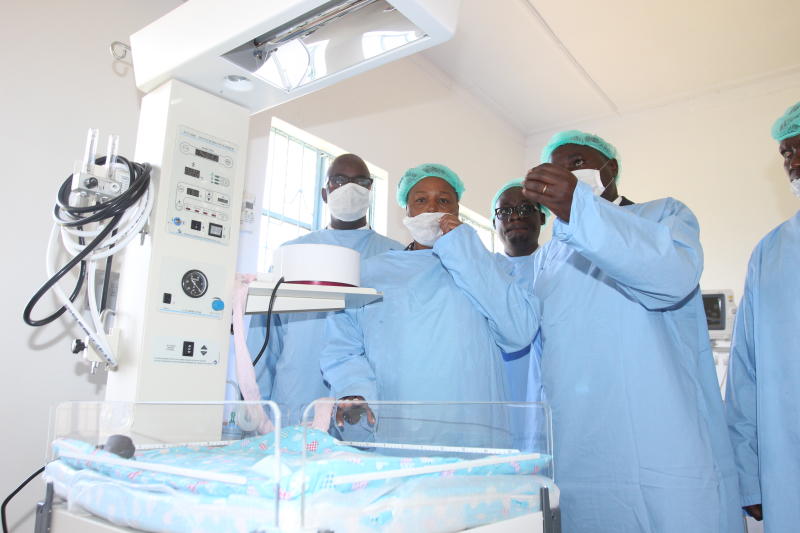
Nyamira County Health CEC Douglas Bosire (right) shows Nyamira County First lady Naomi Nyagarama how a baby warmer works at Manga Sub County Hospital on February 21, 2019. ( Sammy Omingo, Standard)
As countries around the world mark the World Health Day today, Kenya’s quest towards the provision of affordable and accessible health care to its citizens stumbles on.
Years after independence, and after countless pledges and policy statements from successive governments, healthcareremains out of reach for many with cost of treatment remaining punitive and services unavailable.
Late last year, President Uhuru Kenyatta announced the piloting of the Universal Health Coverage (UHC) programme, meant to make healthcare accessible and affordable.
Four pilots were initiated - Nyeri, Isiolo, Kisumu and Machakos were to be the guinea pigs in a broader, more ambitious plan to be rolled out to the rest of the country in three year’s time.
Policy objectives
Policy, such as the UHC announcement, has never really been a stumbling block in the quest for affordable and accessible health care in Kenya.
For instance, the first National Health Sector Strategic Plan (NHSSP-I) was developed 20 years ago as a follow up to the Ministry of Health’s efforts to translate the policy objectives into an implementable programme.
In addition to taking into account past constraints, the document involved key stakeholders in the planning process from the start through consultative workshops within the ministry and with other groups such as development partners, public sector and the then health administration model that included district and provincial health officers, faith based organisations that continue to have a significant footing within the health sector as well as aid agencies.
Somehow though, a combination of poor planning and a lack of financing from subsequent governments threw a spanner in the works, not only for the newly developed policies, but halted whatever progress that had been achieved in the years that followed Kenya’s independence.
“To achieve Universal Health Coverage, it has been calculated that a country should have at least 4.45 health workers per 1,000 people,” Kenya Medical Practitioners, Pharmacists and Dentists Union (KMPDU) Secretary-General Ouma Oluga told Sunday Standard. “Kenya barely reaches 1.79 per 1,000 people.”
Data from the World Health Organisation shows that countries with a near perfect public health system are miles away from the recommended numbers.
Norway, for instance, stands at 19.6 health workers per 1,000 while Switzerland and Finland stand at 21.6 and 26.9 medical personnel per 1,000 people respectively.
Dr Oluga says that all these commitments and plans give no clear guidance on how to finance the health workforce, especially for low- and middle-income countries with limited fiscal space.
“Therefore, many of these strategies, frameworks and implementation plans, although good first steps, are just sitting pretty on a shelf in bureaucrats’ offices,” he says.
To date, the UHC pilots launched with much fanfare in December of 2018 are still undergoing teething problems.
A poor sensitization campaign has resulted in people really not knowing what universal health care is all about. Plus there is the little matter of availability of drugs in government health facilities.
“As a result, many still opt for private medical care as opposed to gambling with a government facility,” an official said.
Kenya has an estimated population of 46 million with an average population growth of one million people per year, with a median age of 19 years and a high (although declining) fertility rate of 4.4 children per woman.
The country is experiencing a population flow from the rural areas to the city centres and currently about 25 per cent of all Kenyans live in an urban setting.
Our burden of disease has historically been mostly focused on communicable diseases. Recent data shows a remarkable increase in the prevalence rates of non-communicable diseases such as cancers and cardiovascular diseases, mainly attributed to lifestyle changes. But it is not all gloom and doom.
“Over the years there has been significant progress in improving several health outcomes and utilisation of health services in Kenya. The child mortality rate in the country significantly dropped by nearly a third since 2003,” a report by The World Bank: Laying The Foundation For A Robust Health Care System In Kenya, states. In three years’ time, the rest of the country will be looking towards the cascading downwards of UHC to the other 43 counties, will the people benefit, or will the timeframe expire with the launch of yet another policy statement?
 The Standard Group Plc is a multi-media organization with investments in media platforms spanning newspaper print
operations, television, radio broadcasting, digital and online services. The Standard Group is recognized as a
leading multi-media house in Kenya with a key influence in matters of national and international interest.
The Standard Group Plc is a multi-media organization with investments in media platforms spanning newspaper print
operations, television, radio broadcasting, digital and online services. The Standard Group is recognized as a
leading multi-media house in Kenya with a key influence in matters of national and international interest.











